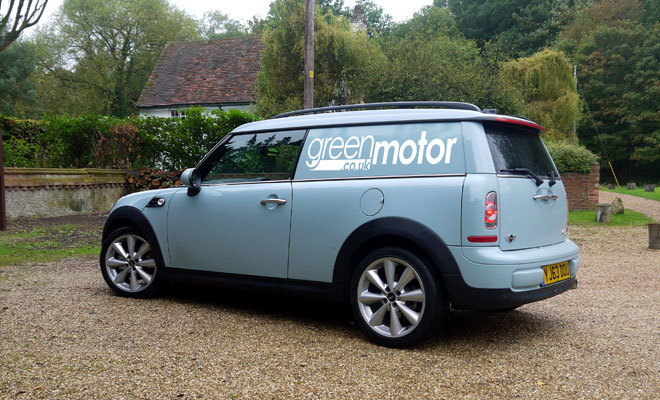by Lem Bingley 
The charming but not very practical Mini Clubman is on its way out, no longer listed among the new-car range at the Mini website. Which means the equally charming and equally impractical Mini Clubvan is no more – indeed I hear that production has already ceased.
It’s not yet clear whether the bigger and more accommodating new Clubman will spawn a second-generation Clubvan, but I doubt it. During two years on sale, fewer than 700 examples of the cheeky little commercial vehicle found buyers and it’s consequently rare to see one out on the road, making tiny deliveries of thoroughly shaken goods.
But rarity should make a classic of the Clubvan pretty quickly, to the extent that I’m almost tempted to invest. I reckon one would look pretty good with the GreenMotor logo splashed across its side.

Cautioning against that urge is the fact that vans are not the safest mode of transport on the road. As insurance company Axa has helpfully pointed out, some of the stats are sobering: van drivers are 47% more likely than other drivers to crash while tailgating, 147% more likely to hit something while reversing, and 23% more likely to have a prang as a result of tiredness.
With the exception of reversing, I don’t suppose the increased risk is innate to vans, more to the way they are driven. White van man is not exactly known for his patience and courtesy on the road.
There are more vans out there than ever before, however. In March this year, there were 29.7 million cars in the UK and 3.5 million light commercials, but the van population is growing at a substantially faster pace – about 2.5 times the rate of car growth. Those occasions when you find a van’s grille looming large in your mirrors seem set to increase.
But despite the drawbacks, the practicality of running a light commercial still has an appeal to me, for some difficult to explain reason.

I’m not aware of any plug-in hybrid vans, which would be my first choice of propulsion, but there are a number of purely electric vans on the market. Nissan’s e-NV200 is probably the most tempting, combining the powertrain of the Leaf electric car with the body of a modestly sized van, providing a range of up to 106 miles and a top speed of 76mph.
Limited range between recharging means an e-NV200 is not going to suit every job but in five-seater Combi format, it would provide highly versatile urban transport. The Combi can be bought outright from £22,859, or from £17,855 with a battery rental deal starting at £61 per month, after the Plug-in Car Grant.

The panel van version of the e-NV200, meanwhile, starts at £17,605 outright or £16,562 with battery leasing, after the contribution of the Plug-in Van Grant.
While the Nissan van is unlikely to become an appreciating classic any time soon, it is a good deal more commodious than the miniscule Clubvan. With a cargo hold measuring 2,040mm long, 1,358mm high and 1,500mm wide the e-NV200 won’t actually be able to swallow a Clubvan whole but it might feel like it, particularly when trying to squeeze things into the Mini’s 860-litre rear. That’s roughly one fifth the capacity of the Nissan.
Mind you, the Clubvan is great fun to drive. Perhaps five times as many journeys to transport the same amount of stuff wouldn’t actually be so bad?

skip to main |
skip to sidebar
Most Popular
-
Mild-mannered hybrid: Kia Sportage 48V driven
-
Family values: Kia Ceed version 3 reviewed
-
Tough mudder: Fiat Panda Cross driven
-
Extraordinary lengths: Mini Clubman reviewed
-
Not so prickly: driving the revamped Citroen C4 Cactus
-
Plush plug-in: Volvo XC60 T8 Twin Engine reviewed
-
Quietly confident: driving the updated Nissan Qashqai
-
Softly, softly: Citroen C5 Aircross reviewed
Browse by Brand
Most Recent
 © 2005 to GreenMotor.co.uk | Contact | Terms & Conditions | Cookies | Privacy | Powered by
© 2005 to GreenMotor.co.uk | Contact | Terms & Conditions | Cookies | Privacy | Powered by  | Close
| Close

